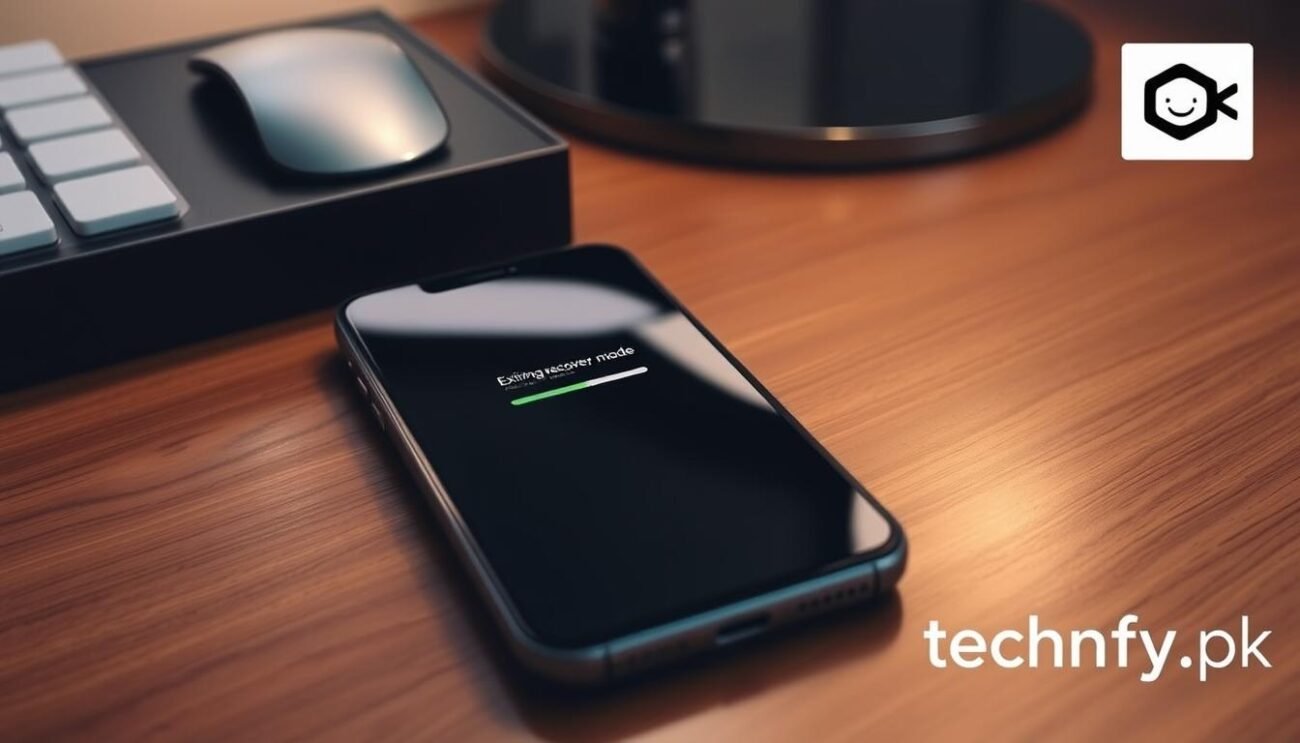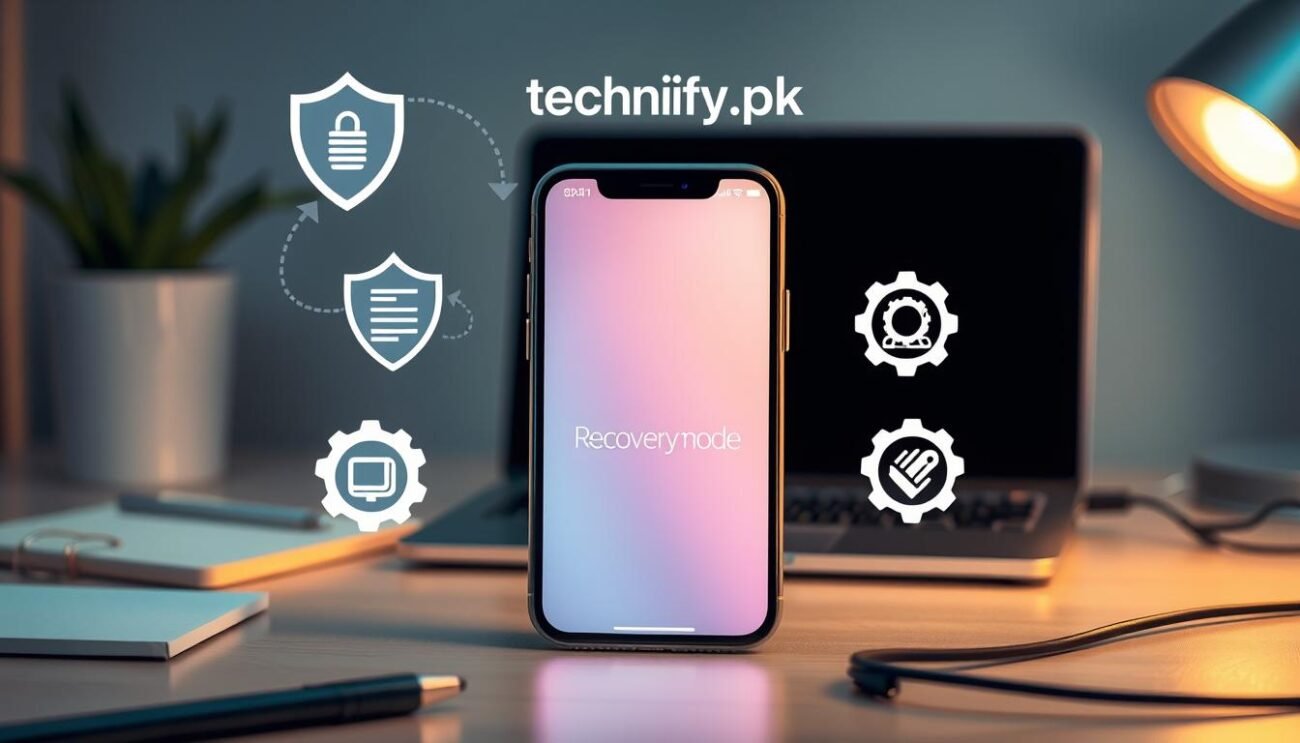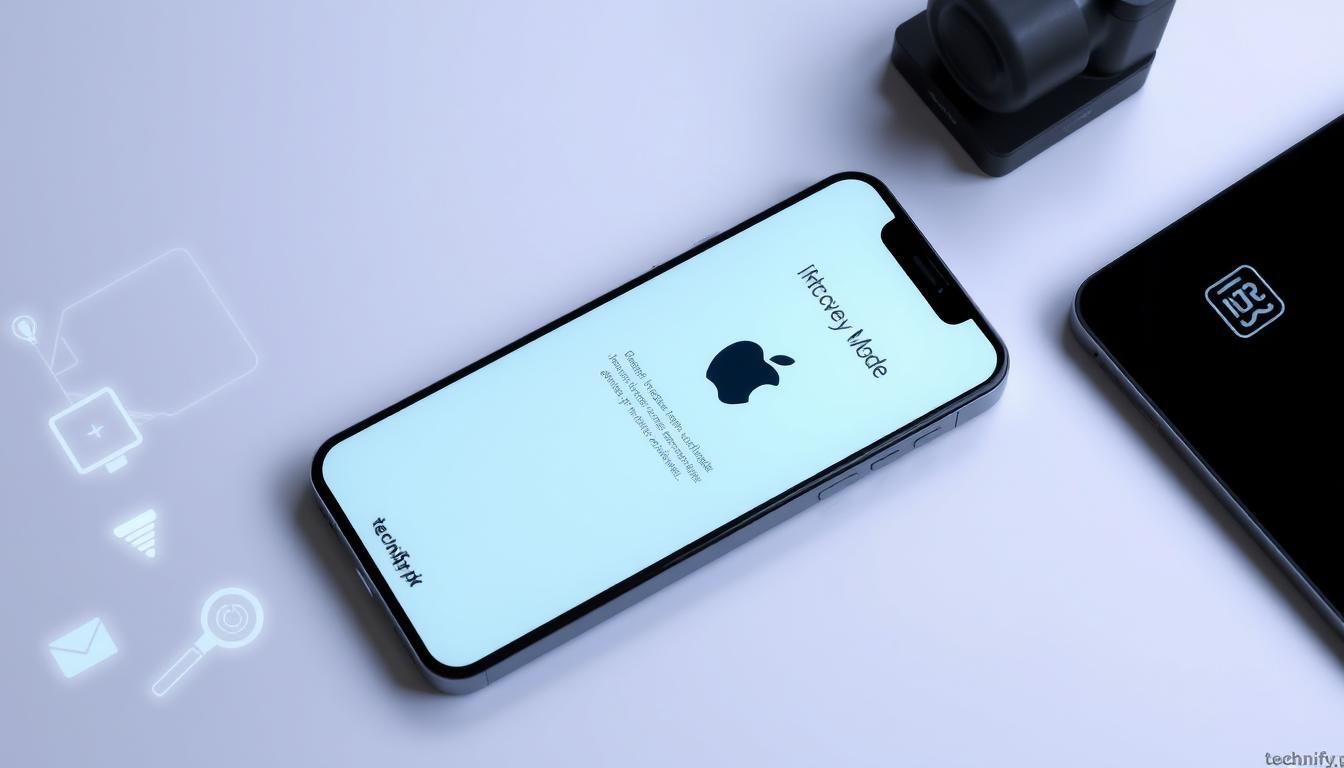Have you ever encountered a situation where your iPhone seemed unresponsive, and you were left scratching your head, wondering how to get it back on track? The solution might lie in the often-overlooked iPhone recovery mode. But what exactly is it, and when should you use it? In this comprehensive guide, we’ll uncover the answers to these questions and provide you with the easy steps to put your iPhone in recovery mode, no matter the model.
Key Takeaways
- Discover the purpose and benefits of iPhone recovery mode for troubleshooting and fixing various device issues.
- Learn the essential preparations to ensure a smooth recovery mode process.
- Explore the step-by-step instructions for entering recovery mode on different iPhone models.
- Understand the common issues and solutions you may encounter during the recovery mode process.
- Discover the data recovery options and alternative solutions when recovery mode fails.
So, are you ready to unlock the secrets of iPhone recovery mode and reclaim control over your device? Let’s dive in!
Understanding iPhone Recovery Mode: What It Is and When to Use It
iPhone’s recovery mode is a powerful troubleshooting tool that can help users resolve a variety of software-related issues. This specialized mode allows you to restore your device’s firmware, update the operating system, or even resolve persistent problems that may be preventing your iPhone from functioning properly.
Common Scenarios Requiring Recovery Mode
Recovery mode is typically necessary in the following situations:
- When your iPhone is stuck in a boot loop or won’t turn on at all
- If your device is experiencing software-related issues, such as a persistent crash or freeze
- When you need to update or restore your iPhone’s operating system
- If you’ve jailbroken your device and the modifications have caused issues
Benefits of Using Recovery Mode
Entering recovery mode can provide several benefits for iPhone users:
- Restore your device to its factory settings, resolving software-related problems
- Update your iPhone’s operating system to the latest version, ensuring compatibility and security
- Troubleshoot and diagnose issues that may be preventing your device from booting up properly
- Regain control of your iPhone if it’s been compromised or infected with malware
Recovery Mode vs. DFU Mode Differences
While recovery mode and DFU (Device Firmware Update) mode are both troubleshooting options for iPhones, they serve different purposes. Recovery mode allows you to restore your device’s software, while DFU mode provides a deeper level of access to the device’s firmware, enabling more advanced troubleshooting and restoring options.
Understanding the differences between these two modes can help you choose the right solution for your specific issue and ensure a successful troubleshooting process.
Essential Preparations Before Entering Recovery Mode
Before putting your iPhone into recovery mode, it’s crucial to take a few essential steps to ensure a smooth and successful process. Restoring an iPhone from recovery mode or fixing an iPhone recovery mode loop can be a delicate procedure, so proper preparation is key to avoiding potential data loss or other complications.
First and foremost, it’s imperative to back up your iPhone data. This can be done by syncing your device with iTunes or Finder, or by using iCloud or a third-party backup service. Safeguarding your important information is the top priority before attempting any recovery mode operations.
Next, make sure you have the latest version of iTunes or Finder installed on your computer. Outdated software can sometimes cause compatibility issues, so keeping your computer’s software up-to-date is essential. Additionally, ensure that you have a stable internet connection, as you may need to download firmware updates or other necessary files during the recovery process.
- Back up your iPhone data
- Update iTunes or Finder on your computer
- Ensure a stable internet connection
By taking these essential preparatory steps, you can significantly increase the chances of a successful restore from recovery mode or resolving an iPhone recovery mode loop. Neglecting these important precautions could lead to data loss or other complications, so it’s crucial to prioritize these tasks before attempting to put your iPhone into recovery mode.
| Preparation Step | Importance |
|---|---|
| Back up iPhone data | Safeguards your important information in case of data loss during recovery mode |
| Update iTunes or Finder | Ensures compatibility and prevents software-related issues during the recovery process |
| Stable internet connection | Allows for necessary firmware downloads and updates during the recovery mode process |
“Preparation is the key to success when it comes to iPhone recovery mode. Take the time to safeguard your data and ensure your software is up-to-date to avoid potential pitfalls.”
How to Put iPhone in Recovery Mode
Putting your iPhone in recovery mode is a crucial troubleshooting step when facing software-related issues. This mode allows you to restore your device and regain control when faced with problems like system crashes, software updates gone wrong, or other malfunctions. Whether you own an iPhone 8 or an older model, the steps to enter recovery mode may vary slightly, but the process is straightforward. Let’s explore the specific steps for different iPhone generations.
Steps for iPhone 8 and Later Models
- Ensure your iPhone is turned off.
- Press and quickly release the Volume Up button.
- Press and quickly release the Volume Down button.
- Press and hold the Side button until the recovery mode screen appears.
Steps for iPhone 7 and 7 Plus
- Turn off your iPhone.
- Press and hold the Volume Down and Sleep/Wake buttons simultaneously.
- Continue holding the buttons until the recovery mode screen appears.
Steps for iPhone 6s and Earlier Models
- Power off your iPhone.
- Press and hold the Home and Sleep/Wake buttons simultaneously.
- Keep holding the buttons until the recovery mode screen is displayed.
Regardless of your iPhone model, once you’ve successfully entered recovery mode, you can proceed to connect your device to your computer and use iTunes or Finder to restore or update your iPhone.
Using iTunes/Finder with Recovery Mode
When your iPhone is in recovery mode, you can leverage the power of iTunes (for Windows) or Finder (for macOS Catalina and later) to restore or update your device. This process can help you restore iPhone from recovery mode or troubleshoot any issues you may be facing.
To begin, connect your iPhone to your computer using a lightning cable. Once connected, iTunes or Finder should automatically recognize your device and indicate that it is in recovery mode. From here, you can initiate the restore or update process:
- In iTunes, click the “Restore” button to reinstall the iOS software on your device.
- In Finder, select the “Restore iPhone” option to reinstall the operating system.
This process will erase all data on your iPhone, so it’s essential to have a recent backup before proceeding. By using iTunes or Finder in recovery mode troubleshooting, you can effectively resolve various software-related issues and get your iPhone back up and running.
| Task | iTunes (Windows) | Finder (macOS Catalina and later) |
|---|---|---|
| Restore iPhone | Click “Restore” | Select “Restore iPhone” |
| Update iPhone | Click “Update” | Select “Update iPhone” |
Remember, the restore iPhone from recovery mode process can be time-consuming, so it’s essential to have patience and follow the on-screen instructions carefully. With the help of iTunes or Finder, you can get your iPhone back to a functional state and continue using your device without any issues.
Common Issues During Recovery Mode Process
While the iPhone recovery mode can be a powerful tool to resolve various software-related issues, users may occasionally encounter a few common challenges during the process. To navigate these challenges effectively, check out our quick guide on entering iPhone 7 recovery mode for step-by-step instructions and helpful tips to get your device back on track.
Error Messages and Their Solutions
One of the most frustrating experiences is encountering error messages while attempting to enter or exit the recovery mode. These messages can range from generic communication failures to more specific issues like “iPhone could not be restored” or “the device is not eligible for the requested build.” In such cases, try the following steps:
- Check your internet connection and ensure your computer has the latest version of iTunes or Finder installed.
- Force-restart your iPhone by pressing the appropriate button combination for your model.
- If the issue persists, you may need to perform a DFU (Device Firmware Update) mode restore, which can help resolve deeper software problems.
Device Not Recognized Problems
Another common challenge is when your iPhone is not recognized by your computer while in recovery mode. This can happen due to a range of factors, such as outdated drivers, faulty USB cables, or even hardware issues. To troubleshoot this:
- Try using a different USB cable or port on your computer.
- Update your computer’s operating system and any relevant device drivers.
- If the device still isn’t recognized, you may need to seek professional assistance, as the issue could be related to a more complex hardware problem.
Failed Recovery Attempts Troubleshooting
Sometimes, the recovery mode process may fail to complete successfully, leaving your iPhone stuck in a loop or unable to exit the mode. In such cases, consider the following steps:
| Issue | Solution |
|---|---|
| iPhone stuck in recovery mode loop | Try force-restarting the device or performing a DFU mode restore. |
| Unable to exit recovery mode | Retry the recovery mode process, or if that fails, seek professional help. |
By being aware of these common issues and following the suggested troubleshooting steps, you can increase your chances of successfully navigating the iPhone recovery mode process and getting your device back to a healthy working state.
How to Exit Recovery Mode Safely
Exiting recovery mode on your iPhone is a crucial step to get your device back to its normal operating state. Whether you’ve successfully resolved the issue that prompted you to enter recovery mode or need to force a restart, it’s essential to follow the right steps to exit safely and avoid any further complications.
Successful Recovery Mode Exit
If your iPhone has completed the recovery process and you’re ready to exit recovery mode, the process is straightforward:
- Disconnect your iPhone from the computer or power source.
- Force restart your iPhone by pressing and quickly releasing the Volume Up button, then the Volume Down button, and finally holding the Side button until the Apple logo appears.
- Your iPhone will now boot up normally, and you can begin using it again.
Forced Exit from Recovery Mode
Sometimes, you may need to force your iPhone out of recovery mode, especially if the normal exit process is not working. Here’s how to do it:
- Force restart your iPhone by pressing and holding the Volume Down and Side buttons simultaneously until the Apple logo appears.
- Your iPhone will now boot up, and you can try entering recovery mode again if necessary.
Remember, exiting recovery mode is a crucial step in restoring your iPhone to its normal functionality. By following the appropriate steps, you can ensure a safe and successful exit, allowing you to continue using your device without any further issues.

Data Recovery Options While in Recovery Mode
When your iPhone is in recovery mode, the conventional methods of data backup and restoration may not be accessible. However, there are alternative options to consider for recovering valuable data from your device. This section explores the various backup recovery methods and third-party recovery tools that can help you restore your iPhone from recovery mode.
Backup Recovery Methods
If you have previously created a backup of your iPhone using iCloud or iTunes, you can use these backups to recover data from iPhone in recovery mode. Simply connect your device to a computer, launch iTunes or Finder, and select the “Restore from Backup” option. This will allow you to restore iPhone from recovery mode and recover your data.
Third-Party Recovery Tools
The PMIC in the iPhone 7 oversees the distribution of power throughout the device. It channels the battery’s energy to various components, such as the processor, display, and other essential systems. This precise power management helps optimize battery life and prevent potential issues related to power fluctuations or imbalances. For tips on addressing power-related issues, check out our easy guide on restarting the iPhone X.
| Recovery Tool | Key Features | Pricing |
|---|---|---|
| Dr.Fone | – Recovers data from iOS devices in recovery mode – Supports various file types (photos, messages, contacts, etc.) – Offers both Windows and Mac versions |
$59.95 for a single license |
| Recover | – Retrieves data from iOS devices in recovery mode – Provides advanced scanning and recovery algorithms – Supports selective recovery of specific data types |
$49.95 for a single license |
| EaseUS MobiSaver | – Recovers data from iOS devices in recovery mode – Offers a user-friendly interface – Supports a wide range of file formats |
$49.95 for a single license |
Remember, while these third-party recovery tools can be effective, they may not be able to recover all of your data, especially if the device has suffered significant damage or data corruption. It’s always recommended to regularly backup your iPhone to ensure the safety of your important information.
Prevention Tips to Avoid Recovery Mode Issues
Experiencing the fix iPhone recovery mode loop or other recovery mode troubleshooting can be frustrating, but there are preventive measures you can take to avoid such situations. By following these tips, you can keep your iPhone running smoothly and minimize the chances of needing to enter recovery mode.
- Stay up-to-date with software updates: Regularly updating your iPhone’s operating system can help address known issues and improve overall device stability, reducing the likelihood of problems that may require recovery mode.
- Back up your data regularly: Maintaining a current backup of your important data can make the recovery process much smoother if you ever need to use recovery mode. This ensures you don’t lose valuable information.
- Avoid unauthorized modifications: Jailbreaking or making unsupported modifications to your iPhone can increase the risk of encountering issues that may require recovery mode. It’s best to stick to official software and settings provided by Apple.
- Handle your device with care: Physical damage, such as dropping your iPhone or exposing it to water, can lead to hardware problems that may necessitate the use of recovery mode. Be mindful of how you handle your device to prevent such incidents.
- Monitor battery and storage: Keeping an eye on your iPhone’s battery level and available storage space can help prevent issues that could trigger the need for recovery mode. Charge your device regularly and manage storage effectively.
By following these prevention tips, you can significantly reduce the chances of encountering situations that would require you to put your iPhone in recovery mode. Taking proactive measures can save you time, effort, and potential data loss.

“Preventing issues is always better than having to troubleshoot them. With a little care and attention, you can keep your iPhone running smoothly and avoid the need for recovery mode.”
Alternative Solutions When Recovery Mode Fails
When the iPhone recovery mode process fails to resolve your device’s issues, there are alternative solutions you can explore. One viable option is to try the DFU (Device Firmware Update) mode, which allows for a deeper level of system restoration. Alternatively, seeking the expertise of professional repair services may be necessary if the problem persists.
DFU Mode Method
The DFU mode is a more advanced troubleshooting step that can help address a wide range of iPhone software-related problems. Unlike recovery mode, which primarily focuses on restoring the operating system, DFU mode allows for a comprehensive firmware update, potentially resolving even the most stubborn issues. If you’re comfortable with the technical aspects, navigating the DFU mode process can be a powerful solution when recovery mode falls short.
Professional Repair Services
In cases where both recovery mode and DFU mode fail to resolve the issue, it’s often best to seek the assistance of professional repair services. Apple’s Genius Bar or authorized service providers can diagnose the problem, identify the root cause, and provide expert-level solutions. This may involve hardware replacements, software reinstallations, or other specialized techniques, ensuring your iPhone is restored to full functionality.













































